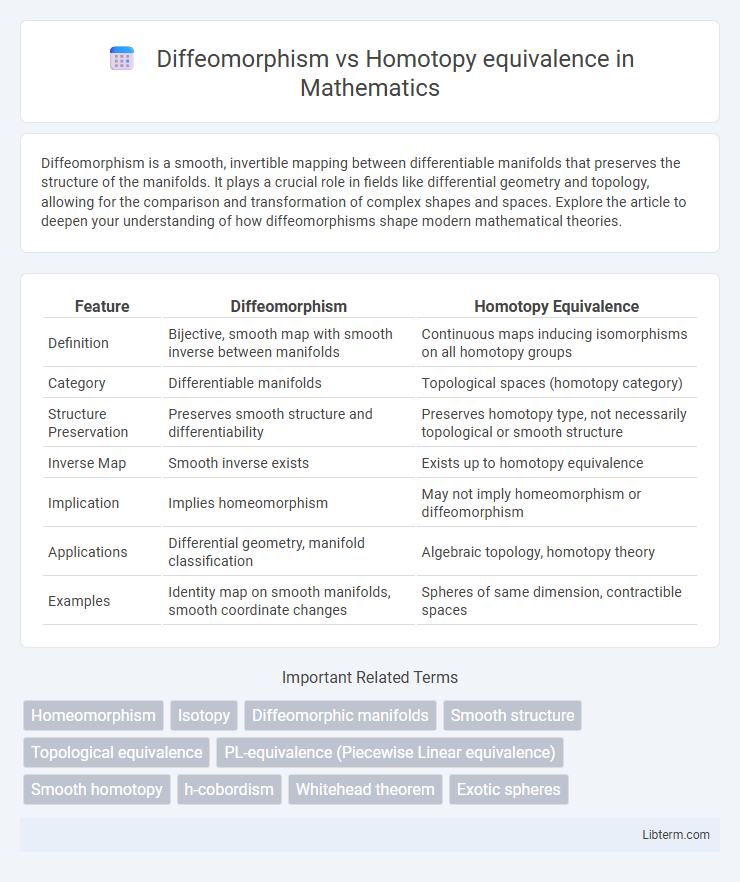Diffeomorphism is a smooth, invertible mapping between differentiable manifolds that preserves the structure of the manifolds. It plays a crucial role in fields like differential geometry and topology, allowing for the comparison and transformation of complex shapes and spaces. Explore the article to deepen your understanding of how diffeomorphisms shape modern mathematical theories.
Table of Comparison
| Feature | Diffeomorphism | Homotopy Equivalence |
|---|---|---|
| Definition | Bijective, smooth map with smooth inverse between manifolds | Continuous maps inducing isomorphisms on all homotopy groups |
| Category | Differentiable manifolds | Topological spaces (homotopy category) |
| Structure Preservation | Preserves smooth structure and differentiability | Preserves homotopy type, not necessarily topological or smooth structure |
| Inverse Map | Smooth inverse exists | Exists up to homotopy equivalence |
| Implication | Implies homeomorphism | May not imply homeomorphism or diffeomorphism |
| Applications | Differential geometry, manifold classification | Algebraic topology, homotopy theory |
| Examples | Identity map on smooth manifolds, smooth coordinate changes | Spheres of same dimension, contractible spaces |
Introduction to Diffeomorphism and Homotopy Equivalence
Diffeomorphism is a smooth, invertible map between differentiable manifolds that preserves the manifold structure and allows for a smooth inverse, forming the foundation of differential topology. Homotopy equivalence concerns the continuous deformation of one topological space into another, capturing the idea of spaces having the same "shape" at a coarse level without requiring smooth structure preservation. Understanding the distinction between diffeomorphism and homotopy equivalence is crucial for classifying manifolds based on their smooth or topological properties.
Defining Diffeomorphism: Core Concepts
Diffeomorphism is a smooth, bijective map between differentiable manifolds with a smooth inverse, preserving the manifolds' differentiable structures and ensuring a one-to-one correspondence in their geometric and topological properties. Unlike homotopy equivalence, which allows for continuous deformation without necessarily preserving differentiability, a diffeomorphism maintains exact smooth structure, making it a stronger and more rigid relation. Key properties include smoothness, invertibility, and preservation of local coordinate charts, integral to understanding manifold equivalence in differential topology.
Understanding Homotopy Equivalence
Homotopy equivalence is a fundamental concept in algebraic topology where two spaces X and Y are considered equivalent if there exist continuous maps f: X - Y and g: Y - X such that the compositions gf and fg are homotopic to the identity maps on X and Y, respectively. This equivalence preserves topological properties related to shape and connectivity, but it does not require the spaces to be differentiably identical, unlike diffeomorphism which demands a smooth, bijective map with a smooth inverse. Understanding homotopy equivalence helps classify spaces up to continuous deformation, focusing on their intrinsic topological structure rather than geometric details.
Key Differences Between Diffeomorphism and Homotopy Equivalence
Diffeomorphism is a smooth, bijective map with a smooth inverse between manifolds, preserving differentiable structure and enabling exact geometric equivalence. Homotopy equivalence involves continuous maps between topological spaces that can be continuously deformed into each other, preserving topological properties but not necessarily smooth structure. The key difference lies in their strictness: diffeomorphism requires smooth isomorphism, while homotopy equivalence only demands topological similarity without preserving fine geometric details.
Examples Illustrating Diffeomorphism
Diffeomorphism refers to a smooth, invertible map between manifolds that has a smooth inverse, exemplified by the identification of a torus with itself under smooth deformations preserving differentiable structure. In contrast, homotopy equivalence concerns continuous deformations without requiring smoothness, such as a sphere and a point being homotopy equivalent due to contraction but not diffeomorphic. Classic examples illustrating diffeomorphism include the smooth bijection between the unit circle and any ellipse, where the differentiable structure remains intact through reparametrization.
Examples of Homotopy Equivalent Spaces
Spheres S^n and n-dimensional Euclidean spaces R^n are classic examples of homotopy equivalent spaces, sharing the same homotopy type despite differing in geometric structure. The torus T^2 and the wedge sum of two circles S^1 S^1 are homotopy equivalent, illustrating how spaces with different topologies can have identical fundamental groups. Homotopy equivalence focuses on continuous deformations preserving topological properties, unlike diffeomorphism which requires smooth bijections and differentiability.
Topological vs. Smooth Structures
Diffeomorphism and homotopy equivalence represent distinct relationships between manifolds, with diffeomorphism indicating a smooth, bijective map preserving differentiable structures, while homotopy equivalence concerns continuous mappings preserving topological properties. Smooth structures distinguish manifolds up to diffeomorphism, encoding geometric and differential properties beyond mere topological equivalence captured by homotopy, which disregards differentiability. The study of topological versus smooth structures reveals crucial differences in manifold classification, where two manifolds can be homotopy equivalent yet not diffeomorphic, highlighting the rigidity introduced by smoothness.
Implications in Differential Topology
Diffeomorphism implies a smooth, structure-preserving bijection between manifolds, ensuring identical differential properties and enabling direct comparisons of geometric features. Homotopy equivalence, by contrast, reflects topological similarity without guaranteeing smooth compatibility, allowing transformation through continuous deformation but not necessarily preserving differentiable structure. In differential topology, diffeomorphism is a stronger condition than homotopy equivalence, affecting classification and rigidity results, where smooth invariants distinguish manifolds beyond homotopy type analysis.
Applications in Mathematics and Physics
Diffeomorphisms provide exact equivalences between smooth manifolds preserving differentiable structures, crucial in differential geometry and the theory of smooth dynamical systems. Homotopy equivalences classify topological spaces up to continuous deformation, playing a key role in algebraic topology and quantum field theory, especially in studying topological invariants. In physics, diffeomorphism invariance underlies general relativity, while homotopy equivalence informs string theory and gauge theories through the analysis of topological defects and solitons.
Summary and Further Reading
Diffeomorphism and homotopy equivalence represent distinct concepts in differential topology and algebraic topology, respectively, with diffeomorphism requiring a smooth, invertible map preserving manifold structures, while homotopy equivalence concerns continuous deformations without strict smoothness conditions. Summaries often contrast their roles in classifying manifolds: diffeomorphism implies a stronger equivalence preserving geometric properties, whereas homotopy equivalence focuses on broader topological similarities. For further reading, foundational texts like Milnor's "Topology from the Differentiable Viewpoint" and Hatcher's "Algebraic Topology" provide in-depth explanations, alongside research articles exploring their interplay in manifold theory and geometric topology.
Diffeomorphism Infographic

 libterm.com
libterm.com